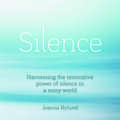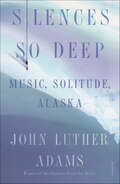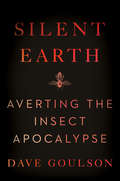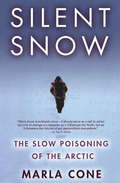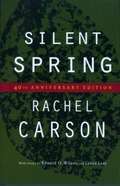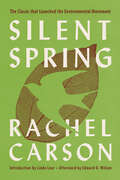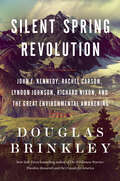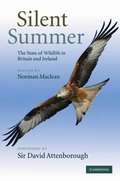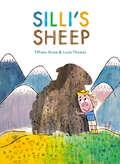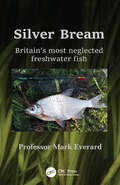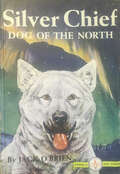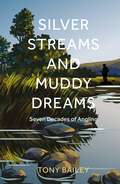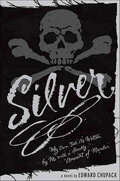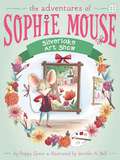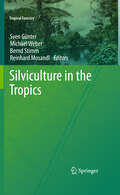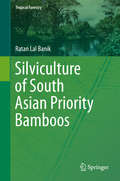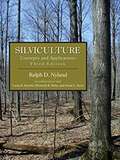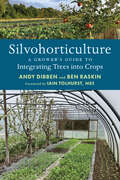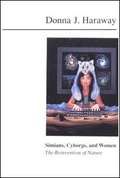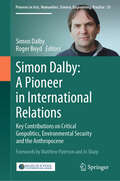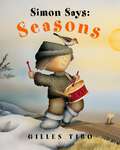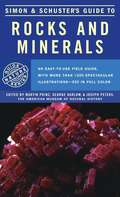- Table View
- List View
Silence: Harnessing the restorative power of silence in a noisy world
by Joanna NylundIn our increasingly frenetic, modern lives, silence has become a treasured commodity. In an era of constant technological stimulation, moments of silence and reflection are harder to achieve than ever before. But what really is silence and what effect does it have on our wellbeing?In Silence, Joanna Nylund reflects on the cultural, scientific and spiritual impact of silence and the ways in which it has impacted our human history, whilst suggesting how we might be able to harness it's power to boost our health. With practical tips and techniques Nylund demonstrates that integrating moments of silence into our everyday routine can increase creativity, improve communication and improve mental health. Silence shows us that moments of quiet are not to be feared but are windows of introspection to embraced and harnessed for our own personal development.(p) Octopus Publishing 2020
Silences So Deep: Music, Solitude, Alaska
by John Luther Adams"[An] illuminating memoir." —Corinna da Fonseca-Wollheim, The New York TimesThe story of a composer's life in the Alaskan wilderness and a meditation on making art in a landscape acutely threatened by climate changeIn the summer of 1975, the composer John Luther Adams, then a twenty-two-year-old graduate of CalArts, boarded a flight to Alaska. So began a journey into the mountains, forests, and tundra of the far north—and across distinctive mental and aural terrain—that would last for the next forty years. Silences So Deep is Adams’s account of these formative decades—and of what it’s like to live alone in the frozen woods, composing music by day and spending one’s evenings with a raucous crew of poets, philosophers, and fishermen. From adolescent loves—Edgard Varèse and Frank Zappa—to mature preoccupations with the natural world that inform such works as The Wind in High Places, Adams details the influences that have allowed him to emerge as one of the most celebrated and recognizable composers of our time. Silences So Deep is also a memoir of solitude enriched by friendships with the likes of the conductor Gordon Wright and the poet John Haines, both of whom had a singular impact on Adams’s life. Whether describing the travails of environmental activism in the midst of an oil boom or midwinter conversations in a communal sauna, Adams writes with a voice both playful and meditative, one that evokes the particular beauty of the Alaskan landscape and the people who call it home.Ultimately, this book is also the story of Adams’s difficult decision to leave a rapidly warming Alaska and to strike out for new topographies and sources of inspiration. In its attentiveness to the challenges of life in the wilderness, to the demands of making art in an age of climate crisis, and to the pleasures of intellectual fellowship, Silences So Deep is a singularly rich account of a creative life.
Silent Earth: Averting the Insect Apocalypse
by Dave Goulson“A terrific book…A thoughtful explanation of how the dramatic decline of insect species and numbers poses a dire threat to all life on earth.” (Booklist, Starred Review)In the tradition of Rachel Carson’s groundbreaking environmental classic Silent Spring, an award-winning entomologist and conservationist explains the importance of insects to our survival, and offers a clarion call to avoid a looming ecological disaster of our own making.Drawing on thirty years of research, Goulson has written an accessible, fascinating, and important book that examines the evidence of an alarming drop in insect numbers around the world. “If we lose the insects, then everything is going to collapse,” he warned in a recent interview in the New York Times—beginning with humans’ food supply. The main cause of this decrease in insect populations is the indiscriminate use of chemical pesticides. Hence, Silent Earth’s nod to Rachel Carson’s classic Silent Spring which, when published in 1962, led to the global banning of DDT. This was a huge victory for science and ecological health at the time.Yet before long, new pesticides just as lethal as DDT were introduced, and today, humanity finds itself on the brink of a new crisis. What will happen when the bugs are all gone? Goulson explores the intrinsic connection between climate change, nature, wildlife, and the shrinking biodiversity and analyzes the harmful impact for the earth and its inhabitants. Meanwhile we have all read stories about hive collapse syndrome affecting honeybee colonies and the tragic decline of monarch butterflies in North America, and more. But it is not too late to arrest this decline, and Silent Earth should be the clarion call. Smart, eye-opening, and essential, Silent Earth is a forceful call to action to save our world, and ultimately, ourselves.Silent Earth includes approximately 20 black-and-white illustrations and charts and graphs.
Silent Snow: The Slow Poisoning of the Arctic
by Marla Cone&“A slender but punch-packing overview of the environmental destruction of the Far North&” from the award-winning environmental reporter (Kirkus Reviews). Traditionally thought of as the last great unspoiled territory on Earth, the Arctic is in reality home to some of the most severe contamination on the planet. Awarded a major grant by the Pew Charitable Trusts to study the Arctic&’s deteriorating environment, Los Angeles Times environmental reporter Marla Cone traveled across the Far North, from Greenland to the Aleutian Islands, to find out why the Arctic has become so toxic. Silent Snow is not only a scientific journey, but a personal one with experiences that range from tracking endangered polar bears in Norway to hunting giant bowhead whales with native Alaskans struggling to protect their livelihood. Through it all, Cone reports with heartbreaking immediacy on the dangers of pollution to native peoples and ecosystems, how Arctic cultures are adapting to this pollution, and what solutions will prevent the crisis from getting worse.
Silent Spring (40th anniversary edition)
by Rachel CarsonSilent Spring became a runaway bestseller, with international reverberations . . . [It is] well crafted, fearless and succinct . . . Even if she had not inspired a generation of activists, Carson would prevail as one of the greatest nature writers in American letters" (Peter Matthiessen, for Time"s 100 Most Influential People of the Century). This fortieth anniversary edition celebrates Rachel Carson"s watershed book with a new introduction by the author and activist Terry Tempest Williams and a new afterword by the acclaimed Rachel Carson biographer Linda Lear, who tells the story of Carson"s courageous defense of her truths in the face of ruthless assault from the chemical industry in the year following the publication of Silent Spring and before her untimely death in 1964.
Silent Spring (Pelican Ser.)
by Rachel Carson Edward O. Wilson Linda LearRachel Carson's Silent Spring was first published in three serialized excerpts in the New Yorker in June of 1962. The book appeared in September of that year and the outcry that followed its publication forced the banning of DDT and spurred revolutionary changes in the laws affecting our air, land, and water. Carson's passionate concern for the future of our planet reverberated powerfully throughout the world, and her eloquent book was instrumental in launching the environmental movement. It is without question one of the landmark books of the twentieth century.
Silent Spring Revolution: John F. Kennedy, Rachel Carson, Lyndon Johnson, Richard Nixon, and the Great Environmental Awakening
by Douglas BrinkleyNew York Times bestselling author and acclaimed presidential historian Douglas Brinkley chronicles the rise of environmental activism during the Long Sixties (1960-1973), telling the story of an indomitable generation that saved the natural world under the leadership of John F. Kennedy, Lyndon Johnson, and Richard Nixon.With the detonation of the Trinity explosion in the New Mexico desert in 1945, the United States took control of Earth’s destiny for the first time. After the Truman administration dropped atomic bombs on Japan to end World War II, a grim new epoch had arrived. During the early Cold War years, the federal government routinely detonated nuclear devices in the Nevada desert and the Marshall Islands. Not only was nuclear fallout a public health menace, but entire ecosystems were contaminated with radioactive materials. During the 1950s, an unprecedented postwar economic boom took hold, with America becoming the world’s leading hyperindustrial and military giant. But with this historic prosperity came a heavy cost: oceans began to die, wilderness vanished, the insecticide DDT poisoned ecosystems, wildlife perished, and chronic smog blighted major cities. In Silent Spring Revolution, Douglas Brinkley pays tribute to those who combated the mauling of the natural world in the Long Sixties: Rachel Carson (a marine biologist and author), David Brower (director of the Sierra Club), Barry Commoner (an environmental justice advocate), Coretta Scott King (an antinuclear activist), Stewart Udall (the secretary of the interior), William O. Douglas (Supreme Court justice), Cesar Chavez (a labor organizer), and other crusaders are profiled with verve and insight. Carson’s book Silent Spring, published in 1962, depicted how detrimental DDT was to living creatures. The exposé launched an ecological revolution that inspired such landmark legislation as the Wilderness Act (1964), the Clean Air Acts (1963 and 1970), and the Endangered Species Acts (1966, 1969, and 1973). In intimate detail, Brinkley extrapolates on such epic events as the Donora (Pennsylvania) smog incident, JFK’s Limited Nuclear Test Ban Treaty, Great Lakes preservation, the Santa Barbara oil spill, and the first Earth Day.With the United States grappling with climate change and resource exhaustion, Douglas Brinkley’s meticulously researched and deftly written Silent Spring Revolution reminds us that a new generation of twenty-first-century environmentalists can save the planet from ruin.Silent Spring Revolution features two 8-page color photo inserts.
Silent Summer
by Norman MacleanOver the past 20 years dramatic declines have taken place in UK insect populations. Eventually, such declines must have knock-on effects for other animals, especially high profile groups such as birds and mammals. This authoritative, yet accessible account details the current state of the wildlife in Britain and Ireland and offers an insight into the outlook for the future. Written by a team of the country's leading experts, it appraises the changes that have occurred in a wide range of wildlife species and their habitats and outlines urgent priorities for conservation. It includes chapters on each of the vertebrate and major invertebrate groups, with the insects covered in particular depth. Also considered are the factors that drive environmental change and the contribution at local and government level to national and international wildlife conservation. Essential reading for anyone who is interested in, and concerned about, UK wildlife.
Silkies and Other Guinea Pigs (World Book's Animals of the World)
by Dan BlunkTopics include: different kinds of guinea pigs, how they are cared for and shown, and where they came from.
Silli's Sheep
by Louis Thomas Tiffany StoneFor fans of Sophie's Squash and other super-silly picture books, here is the endearing story of a man named Silli who tries to tame the wind in ridiculous ways.Silli lives in the middle of a meadow, in the open air. One morning, a gust of wind pays a visit--brrrr! What if the wind comes to stay? If only Silli could find some sheep, he'd have wool to knit a sweater to keep him warm. Luckily, he spots five large "sheep" up on a hill--perfect! It's just too bad they're resistant to herding and their wool is incredibly hard. But when Silli leans against them, they block the wind and keep him warm. . . . Perhaps he can build a shelter made of sheep? And so he resourcefully arranges his sturdy sheep (which are actually sheep-shaped rocks) into a little hut, and is finally warm and dry. This charming story--crafted in the tradition of folkloric characters who are well-meaning, likeable, and also a bit ridiculous--is sure to have a ton of kid appeal.
Silver Bream: Britain’s most neglected freshwater fish
by Mark EverardThis book is dedicated to the Silver Bream, a fish too long neglected by anglers, wildlife enthusiasts and science. In fact, this is the first book ever devoted to this freshwater fish. Scientist, author and broadcaster Dr Mark Everard introduces the biology of the silver bream, angling for this fish, and its diverse social quirks and values.
Silver Brumbies of the South (Silver Brumby #3)
by Elyne MitchellThowra, the most beautiful brumby stallion ever to gallop across the great Main Range, is disturbed by men bringing machinery and noise to the area of the mountains which he roams. Storm also has been uneasy and has taken his mares and sons further south. When they meet they decide to take the restless young stallions, Lightning and Baringa, further to the south where they will have to fight for a place with the herds already there. Lightning and Baringa become competitors, with Lightning always trying to steal Baringa's mares. Baringa saves Lightning three times but each time he knows: he will have to fight Lightning again next spring.
Silver Chief: Dog of the North (Famous Dog Stories and Silver Chief #1)
by Jack O'BrienSilver Chief is the son of a Husky whose father was a wolf. After his mother is killed he hates all mankind until a Canadian Mountie shows him kindness.
Silver Streams and Muddy Dreams: Seven Decades of Angling
by Tony Bailey‘A joyful drift through an angling life. Poignant meanders with plenty of hooks to snare any angler looking for literary immersion.’ – Kevin Parr, author of The Quiet Moon: Pathways to an Ancient Way of Being and Rivers Run: An Angler’s Journey From Source to SeaTony Bailey has been obsessed with fish his whole life (or, at least, what he can remember of it). As he reached his preteen years, this turned into a love for angling, which has stayed with him throughout his life and ensured he would spend the next seventy-odd years gladly indulging in his passion. In Silver Streams and Muddy Dreams, he looks back over a life spent fishing and considers what lights the spark that turns a human being into an angler – circumstance, social contact or genetics?Packed with memories and peppered with useful tips and observations, Tony explores the full gamut of angling possibilities, from the wildest stream to the most enigmatic of farm ponds, each tied to their histories and legends and each capable of providing the thrill of a lifetime or the peace and tranquillity to connect with nature and soothe the mind.
Silver: My Own Tale As Written by Me with a Goodly Amount of Murder
by Edward ChupackI am Silver, and there is no other pirate like me on these waters.This being the last testament of the infamous pirate Long John Silver, you would do well not to trust a word in its pages. Held captive aboard his own ship, the Linda Maria, he is to be taken to England, where he will hang at the king's pleasure. But he has another plan: to tell a tale of treason, murder, a lost treasure that would rival King George's own riches, and what really happened on Treasure Island . . . if Long John Silver is to be believed. But is he?His beginnings as a pickpocket on the streets of Bristol are as dark as the rest of his deliciously devious life. Taken to sea by the pirate captain Black John, Silver soon learns the arts of his trade: the sword, saber, and pistol. He makes his trade in plundering, cheating, ransacking, and murder---more murders than he can bother to count. British, Frenchmen, Spaniards, and Portuguese all fall before him. He takes exceptional pleasure in murder, but never such pleasure as he finds in his search for a most uncommon treasure. To find that treasure he must heed the words of a dead man, solve the ciphers in a well-worn Bible, forgo the love of an extraordinary woman, and climb over the corpses of friend and foe alike to arrive at Treasure Island and find his fortune.But Silver's tricks are never done. Before he greets the hangman at Newgate Square, he will have one last secret to reveal. Hidden in these pages are clues that lead to his remarkable discovery. And although King George's bounty for this notorious scourge may be handsome indeed, the captain who has captured Silver would not mind adding Silver's riches to his own purse. He will let Silver tell his tale in the hope of learning clues to the treasure's location. And if you were to mark his words as well, you might discover the whereabouts of that treasure yourself. So we shall, for now, allow Long John Silver to spin his stories, tales of adventure and betrayal, gold and jewels, love and murder.And he will never leave out the murder. Not Long John Silver.
Silverlake Art Show (The Adventures of Sophie Mouse #13)
by Poppy GreenIn this thirteenth charming book of The Adventures of Sophie Mouse series, Sophie hosts the very first Silverlake Art Show!Sophie has a brilliant idea: she&’s going to host the very first Silverlake Art Show! After all, she loves to draw and paint and she likes looking at art too. With the help of Hattie Frog and Owen Snake, Sophie puts together the whole event. And when the big night comes, she expects to be the star of the show. But she gets a surprise when she realizes…she&’s not! Who is this mystery artist that everyone is chirping and buzzing about? With easy-to-read language and illustrations on almost every page, the Adventures of Sophie Mouse chapter books are perfect for beginning readers.
Silviculture in the Tropics
by Michael Weber Bernd Stimm Reinhard Mosandl Sven GünterThis book integrates the latest global developments in forestry science and practice and their relevance for the sustainable management of tropical forests. The influence of social dimensions on the development of silvicultural concepts is another spotlight. Ecology and silvicultural options form all tropical continents, and forest formations from dry to moist forests and from lowland to mountain forests are covered. Review chapters which guide readers through this complex subject integrate numerous illustrative and quantitative case studies by experts from all over the world. On the basis of a cross-sectional evaluation of the case studies presented, the authors put forward possible silvicultural contributions towards sustainability in a changing world. The book is addressed to a broad readership from forestry and environmental disciplines.
Silviculture of South Asian Priority Bamboos
by Ratan Lal BanikThis monographaims at bringing out a comprehensive collection of information on bamboovarieties in South Asia. The main focus of this book is to address theecological and economic significance of bamboos. Bamboo is a versatile group of plants, capable of providing ecological,economic and livelihood security to the people. In the tropics, especially therural areas in different countries of South Asia, most of the houses aremade of bamboos. In the hilly areas of Bangladesh, Bhutan, Nepal and India, thetribal people take bamboo shoots as one of their major food items sinceprehistoric days. With palatableshoots and grass like leaves bamboo plants have also been liked by many herbivore animals, such as, elephants,the wild cattle, Indian Bison, and some speciesof deer. The red-panda in the Himalayas, and primates,pigs, rats and mice, porcupines, and squirrels are also incidental feeders onsoutheast Asian bamboos. There has been a growing awareness in recent years about the values ofbamboo being an important means of economic growth and for improving thesocio-economic conditions of the rural poor. Bamboo as an industrialmaterial can substitute wood and that to at low cost. Due to increasing demandand squeezing of bamboo area the plants have been overexploited and the qualityand quantity of resource alarmingly getting depleted. Besides many new bamboobased industries have come up which also urgently require uninterrupted supplyof species wise bamboo resource. The south Asia region has bestowed with more than 300 bamboospecies with enormous diversities at species, ecological and geneticallevel. A number of bamboo species are found common among countriesof the region selected for various utilization potentials having wide range of ability to adjustenvironmental conditions of these countries and thus prioritized forcultivation. Both government and private planters in the region have started allocating funds, land andother logistics to raise large scale plantation of desired bamboospecies. This book has been drafted to find out answers of the most pertinentqueries based on the field observations on each of the bamboo species andknowledge learnt from the indigenous people living with bamboos in differentparts of south-east and south Asian countries. This monograph would beinteresting and useful to bamboo professionals, foresters, horticulturists,field level extension workers, nurserymen, planters, industrial entrepreneurs,ecologists, and valuable source of reference to the relevant researchers andstudents in the region.
Silviculture: Concepts And Applications
by Ralph D. NylandSilviculture: Concepts and Applications reflects a belief that all the tools of silviculture have a useful role in modern forestry. Through careful analysis and creative planning, foresters can address a wide array of commodity and nonmarket interests and opportunities while maintaining dynamic and resilient forests. A landowner's needs, circumstances, and site conditions guide a silviculturist's judgment and decision making in finding the best ways to integrate the biologic-ecologic, economic-financial, and managerial-administrative requirements at hand. The Third Edition of this influential text provides a foundational basis for rigorous discussion of techniques. The inclusion of numerous real-world examples and balanced coverage of past and current practices broadens the concept of silviculture and the ways that managers can use it to address both traditional and emerging interests in forests. A thorough discussion of new and proven interpretations increasingly directs the attention of foresters toward the role silviculture plays in creating, maintaining, rehabilitating, and restoring forests that can sustain an expanding variety of ecosystem services.
Silvohorticulture: A grower's guide to integrating trees into crops
by Andy Dibben Ben Raskin"Dibben and Raskin offer an insightful, inspiring but also exceptionally practical guide to integrating trees into annual cropping systems. . . in this book we see how the phrase 'the sky’s the limit' has never been more applicable."—Jesse Frost, author of The Living Soil Handbook An invaluable handbook for farmers, growers, and gardeners, Silvohorticulture is the first book to offer a detailed, practical guide on how to effectively integrate trees with vegetable growing, offering information previously known only in the foresting world. Drawing on the decades-long experiences of Ben Raskin and Andy Dibben, both of whom have designed and managed agroforestry systems and have extensive experience in commercial horticultural crop production, this is the definitive book on the interaction between trees and crops, covering the benefits of trees for edible crops and the potential for additional crops from trees, plus crucial new information on how to fit trees into complex crop rotations as well as manipulating access to light. Ben and Andy also reveal the latest research on how tree roots behave and, importantly, how that impacts your crops. Agroforestry can bring immense benefits to farmers and growers—not just optimizing yield, but also improving soil, managing pests and water, increasing biodiversity, and reducing costs. System design must be customised to each grower’s requirements, and Silvohorticulture offers step-by-step detail that will allow you to manage your trees and crops successfully. "In this immensely practical guide, the authors provide the technical details towards integrating trees with vegetables and other crops, all while dispelling any preconceived notions that this idea reduces productivity or function. In fact, these systems might prove essential for farm resilience in a changing climate."—Steve Gabriel, author of Silvopasture
Simians, Cyborgs, and Women: The Reinvention of Nature
by Donna J. HarawayA collection of ten essays written mostly during the eighties. With a feminist perspective and the premise that nature is constructed, rather than discovered-- and that truth is made, not found-- Haraway provides an analysis of the popular and scientific struggles involved in the telling of evolutionary tales. The author is a historian of science at the U. of California, Santa Cruz.
Simon Dalby: Key Contributions on Critical Geopolitics, Environmental Security and the Anthropocene (Pioneers in Arts, Humanities, Science, Engineering, Practice #35)
by Simon Dalby Roger BoydThis book profiles Simon Dalby’s academic contributions in the fields of critical geopolitics, environmental security and the intersection of international relations and the Anthropocene. It includes reprints of key essays that highlight innovations in critical thought at the intersections between geopolitics, environment and security. Starting with an analysis of American reconstructions of the Soviet threat in the 1970s, an early contribution to the emerging field of critical geopolitics, subsequent papers focus on the emergent formulations of environmental security in the aftermath of the Cold War and the environmental costs of globalization. Focusing on the implicit geographical framing in discourses of globalization offered a critique that extended the ambit of critical geopolitics to grapple with the issues of environmental security and the rising concern with climate change as well as the political identities invoked in that debate. In the aftermath of 9/11, similar arguments about contextualization applied to the American global war on terror and the revival of discussions of empire and its geographies, both in arguments for invading Iraq, as well as the wider discussions in policy discourse and popular culture. Simultaneously, the emergence of earth system science and the concept of the Anthropocene offered another way to highlight the dangers of fossil fueled economic activities. The necessity of fundamentally rethinking the premises of security policy in light of this recontextualization is emphasized in more recent contributions on climate security and the current ecological crisis. Critical geopolitics Environmental security Global war on terror Firepower in the Anthropocene
Simon Says: Seasons (Simon)
by Gilles TiboMeet Simon, a little boy with big dreams. His imagination leads him to all kinds of wonderful adventures. With the help of his friend, Marlene, and with his own special spirit, Simon makes each season a memorable one.Simon welcomes spring — As the snow begins to melt, Simon decides he will hurry spring’s arrival. When his drum fails to call it forth, he tries fantastic but charmingly imaginative ways to pull flowers from the earth, tempt birds to return, and encourage bears to awaken — only to discover that spring will come in its own time, despite what we try to do to make it come any sooner.Simon in summer — Simon loves summer so much that he never wants it to end. When he sees the first signs of fall, he seeks advice from a heron and a cow, who tell him how to make summer last. Simon tries by making the frogs sing, pleasing the butterflies with paper flowers, and keeping the sun high in the sky.Simon and the wind — Simon tries to use the wind to fly. As he blows bubbles into the breeze, he thinks he can make one large enough to carry him. His friend Marlene brings him a cardboard box, and Simon asks the birds to carry it like a plane across the sky. Finally, Simon learns he cannot fly, but discovers a game he and his friends can play with the wind.Simon and the snowflakes — Simon is curious. He wants to know how many snowflakes fall in a snowstorm, but they come down too fast to count. When he learns that there are as many snowflakes as stars in the sky, he tries to count them too, but they race across the night sky. Simon decides to visit his friends in the forest and finds something much better to count there.
Simon and Schuster's Guide to Rocks and Minerals
by Simon Martin Prinz George Harlow Joseph Peters Annibale Mottana Rodolfo Crespi Giuseppe Liborio Schuster StaffAn easy to use field guide that contains everything rock and mineral enthusiasts need to know with more than 1,000 spectacular illustrations--600 in full color! Practical, concise, and easy to use, Simon & Schuster's Guide to Rocks and Minerals contains everything that the rock and mineral enthusiast needs to know. This field guide is divided into two large sections--one devoted to minerals and one to rocks, each prefaced by a comprehensive introduction that discusses formation, chemistry, and more. All 377 entries, beautifully illustrated with color photographs and helpful visual symbols, provide descriptions and practical information about appearance, classification, rarity, crystal formation, mode of occurrence, gravity of mineral, rock chemistry, modal classification fields, formational environments, grain sizes of rocks, and much more. Whether you are a serious collector or an information-seeking amateur, this incomparably beautiful, authoritative guide will prove an invaluable reference.
Simple Acts to Save Our Planet: 500 Ways to Make a Difference (Simple Acts Gift Series)
by Michelle NeffSimple Acts to Save Our Planet shows you how to be more active in saving our planet every day by performing some &“Simple Acts of Kindness&”—for the Earth.Treat the environment with kindness with these easy, manageable activities that range from simple home updates, to gardening basics, to supporting the local community. You&’ll learn simple techniques to help protect the planet every day, like starting a compost pile to reduce food waste, utilizing travel mugs and reusable containers, and choosing eco-friendly products. By working to implement these simple strategies into your everyday life, you can take an active stand to protect the environment now— and make a real difference for the future.
